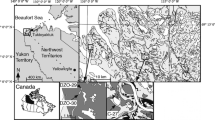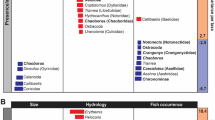Abstract
The temporal and spatial variability in the midge assemblage found in a backwater lake of the Mississippi River was examined. Bi-weekly samples were taken during the summers of 1987 and 1988. Four taxa of chironomids were found. The population density and sizes of chironomids, and the proportion that each taxon comprised of the midge assemblage, varied significantly in time and space. In an attempt to examine whether the variability noted was related to sediment accretion in the lake, sedimentation rates were measured. There were few correlations among sedimentation rate or the organic matter content of the collected sediment and the structure of the midge assemblage. Those few correlations that were statistically significant were low and often paradoxical. For example negative relationships were found between the density and size of Chironomus spp., a detritivore, and the amount of sediment deposited or its organic matter content. Also no significant relationships were found between the density of the predator Cryptochironomus spp. and the density of other chironomids (potential prey). These negative findings indicate that factors other than food, such as sediment texture, may be more important than food availability in structuring chironomid assemblages in backwater areas. There was spatial variability in the densities and sizes of chironomids that may be explained by differences in sediment texture and organic matter. This suggests that short-term inputs of sediment (as ascertained by sediment traps) may not greatly influence midge assemblages while the long-term changes in sediment composition may have large influences.
Similar content being viewed by others
References
Bhowmik, N. G. & J. R. Adams, 1989. Successional changes in habitat caused by sedimentation in navigation pools. In P. G. Sly & B. T. Hart (eds), Sediment/Water Interactions IV. Developments in Hydrobiology 50. Kluwer Academic Publishers, Dordrecht 17–27. Reprinted from Hydrobiologia 176/177.
Coffman, W. P., 1978. Chironomidae. In R. W. Merritt & K. W. Cummins (eds), An introduction to the aquatic insects of North America. Kendall/Hunt Publishing, Dubuque, Iowa, 345–376.
Eckblad, J. W. 1986, The ecology of Pools 11–13 of the upper Mississippi River: a community profile. U.S. Fish Widl. Serv. Biol. Rep. 85. 90 pp.
Eckblad, J. W., N. L. Peterson, K. Ostlie & A. Temte, 1977. The morphometry, benthos and sedimentation rates of a floodplain lake in Pool 9 of the upper Mississippi River. Am. Midl. Nat. 97: 433–443.
Eckblad, J. W., C. S. Volden & L. S. Weigart, 1984. Allochthonous drift from backwaters to the main channel of the Mississippi River. Am. Midl. Nat. 111: 16–22.
Grzybkowska, M., 1989. Production estimates of the dominant taxa of Chironomidae (Diptera) in the modified, River Widawka and the natural, River Grabia, Central Poland. Hydrobiologia 179: 245–259.
Hornbach, D. J., T. Deneka, B. S. Payne & A. C. Miller, 1989. Benthic macroinvertebrate community structure in a backwater lake of Pool 2, upper Mississippi River. J. Freshwat. Ecol. 5: 131–138.
Hornbach, D. J., T. Deneka, A. C. Miller & B. S. Payne, 1991. Variations in the rate of sediment accumulation in a backwater bake, Pool 2, Mississippi River. J. Freshwat. Ecol., in press.
Jahn, L. A. & R. V. Anderson, 1986. The ecology of Pools 19 and 20, upper Mississippi River: a community profile. U.S. Fish Wild. Serv. Biol. Rep. 85: 142 pp.
Johnson, R. K., 1987. Seasonal variation in diet of Chironomus plumosus (L.) and C. anthracinus Zett. (Diptera:Chironomidae) in mesotrophic Lake Erken. Freshwat. Biol. 17: 525–532.
Kajak, K., 1987. Determinants of maximum biomass of benthic Chironomidae (Diptera). Ent. Scand. Suppl. 29: 303–308.
Mackay, A. P., 1977. Growth and development of larval Chironomidae. Oikos 28: 270–275.
Nolte, U., 1990. Chironomid biomass determination from larval shape. Freshwat. Biol. 24: 443–451.
Oliver, D. R., 1971. Life history of the Chironomidae. Ann. Rev. Ent. 16: 211–230.
Pinder, L. C. V., 1986. Biology of freshwater Chironomidae. Ann. Rev. Ent. 31: 1–23.
Rae, J. G., 1985. A multivariate study of resource partitioning in soft bottom lotic Chironomidae. Hydrobiologia 126: 275–285.
Robbins, J. A., T. Keilty, D. S. White & D. N. Edgington, 1989. Relationships among tubificid abundances, sediment composition, and accumulation rates in Lake Erie. Can. J. Fish. aquat. Sci. 46: 223–231.
Smart, M. M., R. G. Rada, D. N. Nielsen & T. O. Claflin, 1985. The effect of commercial and recreational traffic on the resuspension of sediment in Navigation Pool 9 of the upper Mississippi River. Hydrobiologia 126: 263–274.
Author information
Authors and Affiliations
Rights and permissions
About this article
Cite this article
Hornbach, D.J., Deneka, T., Hu, M. et al. Temporal and spatial variability in midge assemblages from a backwater lake in Pool 2, Mississippi River. Hydrobiologia 252, 133–141 (1993). https://doi.org/10.1007/BF00008151
Received:
Revised:
Accepted:
Issue Date:
DOI: https://doi.org/10.1007/BF00008151




